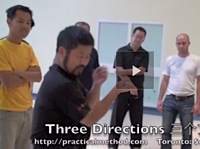Taiji is supposed to be about relaxation. If that is the case, why is there such a heavy emphasis on low stances in Chen style? Doesn’t that contradict the requirement for relaxation?
The term “relaxation” is a poor word to express an important point. Relaxation is often associated with a form of limpness. Furthermore, tension and relaxation are usually treated as contradictory. However, there is a form of tension achieved through relaxation in taiji. Granted, it is not the form of tension we intuitively think of when we engage in other forms of exercise. Nevertheless, it is a kind of tension. When we are told to relax, what is usually meant is that we have to give up on using awkward strength to be able to express a more efficient form of strength.
This idea applies to the issue of leg strength. What I have found helpful in the past is to hold the stance as long as I can (to the point where my legs are so tired I feel I can no longer hold them) and then to focus on relaxing the muscles. By doing this, I have found that I need to adjust my stance slightly. By that, I do not mean that it will be higher, but that it will be aligned differently. By trying to relax the muscles, I usually have been able to find the proper alignment in the legs, and my low stances require much less muscular effort than they did in the past. In fact, they end up being sounder from a structural perspective.
One of the first times I understood this was last year, during a short period of full time training. After repeating the form for many hours during the day, my muscles simply could not do the work. It forced my body to find the proper alignment to relax the muscles, thereby expressing the tension that makes for better taijiquan.



{ 4 comments… read them below or add one }
Thanks JP, I had the same experience.
Regards.
Hi, Jay and Jean-Philippe
Before I started Chen PM and Hunyuan Taijiquan, I had spent half a decade training in Hebei Xingyiquan. Holding postures is considered a very fundamental practice; perhaps you can say that the entire system is built upon that foundation. So I can very much relate to and am sympathetic towards the self torture that you have to endure through posture holding. Some of the “tensions” you might be referring to are points or spots where the “energy” of your shape or posture is “caught.” What you might be doing in these little “adjustments,” as you call them, is filling out the shape with more efficiency and releasing the spots of indentation or protrusion. As you continue, you will have to seek out where these spots are – and that may get trickier as they get smaller and thinner and harder to find. After a while you should be able to feel this on other people through contact. “Expressing the tension” if we are on the same page, would be a fairly accurate decription of the process.
Does this make sense to you?
After years of training, I still mostly work on just the very basic fundamentals – advanced ability means having well developed fundamentals.
P.S. As my teacher occasionally says, If it feels easy to you, you are either doing it correctly or very very wrong! Haha. Usually the later is true.
“[W]e have to give up on using awkward strength to be able to express a more efficient form of strength.”
According to Moshe Feldenkrais, “the sensation of effort is the subjective feeling of wasted movement.” When I pull off a well-executed application, I marvel at how little effort I felt on my own body. One student of mine really struggles with this feeling; he has the ingrained expectation that the physical manipulation of his opponent requires strenuous and strained effort. When he is able to perform a correct Taiji application on me and I affirm its correctness, he is flabbergasted and thinks I was letting him win. I tell him that he must do this type of movement in application over and over until he gains a comfortable familiarity with this “more efficient form of strength”.
i agree in pentjak silat , kuntao, and Taiji if you use more muscle to do the application/takedown than you use to sneeze . Your doing it wrong. which for me im still working on.